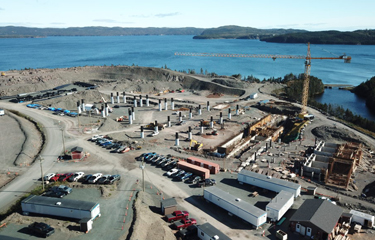Placentia Bay, on the southeast coast of Newfoundland, Canada, provides an ideal “virgin area” for farming salmon and helping Grieg Seafood ASA (GSF) to reach its new harvest goal of 150,000 metric tons (MT) within the next five years, according to CEO Andreas Kvame.
Last month, Bergen, Norway-headquartered GSF announced the acquisition of new Canadian salmon farming venture Grieg Newfoundland AS, a greenfield project that has exclusive rights for salmon farming in Placentia Bay. The company already has farming activities in Norway’s Rogaland and Finnmark regions, as well as British Columbia and Shetland.
Currently comprising 11 farming licenses, three of which have already been approved, Placentia Bay – with a total length of 130 kilometers – is a “unique opportunity for growth,” Kvame said while speaking at the North Atlantic Seafood Forum (NASF) 2020.
“It’s very seldom that you get a new area that you have to yourself, but this will be exclusive to Grieg Seafood for 20 years,” he said. “It’s double the size of all of Rogaland.”
Kvame said that as a farming area, Placentia Bay also offers a very similar geography and conditions to its Norwegian operations, while the nearest other farm will be 200 kilometers away.
“Why are we going in there? Apart from being a very good area for salmon farming, it’s very close to the U.S. market, which is the world’s largest market for Atlantic salmon, consuming around 530,000 MT in 2019. The North American market also showing very good consumption growth at 6.2 percent CAGR, but its production has been stable for the last five years (between 152,000 and 148,000 MT),” he said. “We believe that in combination with our operations in British Columbia, this will be a benefit to serving the fastest growing market.”
The first phase of the Placentia Bay project will aim to supply an annual harvest of 15,000 MT of salmon from 2025, with the first fish expected at the end of 2022 or start of 2023. Phase two will increase this volume to 33,000 MT, and the long-term potential is an “absolutely doable” 45,000 MT, Kvarme said.
At the same time, the company will strive to achieve cost levels of the project in line with its latest Norwegian operations.
Three more of Placentia Bay’s licenses are expected to be approved this year, while the rest are in different stages of application. A recirculating aquaculture system (RAS) facility is also included in the project, with construction already underway. This will house a hatchery, a smolt facility, and three post-smolt modules with a potential annual capacity of 7,000 MT. The first eggs are expected to go into the hatchery in the summer.
“For the first time, we are able to start from scratch, which will be a huge benefit coming into this area as we will be delivering state-of-the-art from the very beginning,” Kvarme said.
The project received environmental impact study (EIS) approval in August 2018.
Kvame also said at NASF that as a salmon farming company, GSF “believes in growth.” Last year, it produced a record 83,000 MT of salmon and generated a turnover of NOK 8.3 billion (USD 826.9 million, EUR 735.4 million).
For 2020, the target volume is 100,000 MT and is based on a strategy prepared in 2016-17, when it was producing around 62,000 MT.
“We are quite confident that we will reach this,” he said. “We have also said that we should have a production cost at or below the industry average. I think we can say now that we will reach the industry average or do even better in the Norwegian regions, we will also reach the target for British Columbia, but we will need another year in Shetland to reach the cost target that we have set,” Kvame said. “Grieg wants to be part of the global growth of the salmon sector. We have put up a new target of 150,000 MT, which should be reached within 2025 – coming from 100,000 MT this year. Most of that will come from organic growth from our existing operations and improvements. Another part of that will be our new region in Newfoundland – Placentia Bay.”
Alongside its global growth plan, GSF’s 2025 strategy will also make cost competitiveness and value chain repositioning key focus areas, with the latter exploring new value-adding and downstream opportunities, Kvarme said.
Photo courtesy of Grieg NL







